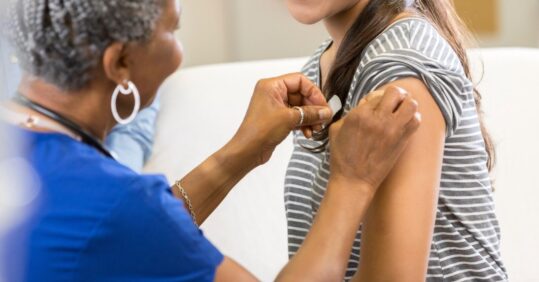HPV vaccine has changed strains in circulation ‘impacting screening plans’

Vaccination against HPV appears to have changed the mix of human papillomavirus strains in circulation, say researchers who have spotted the ‘strain replacement’ for the first time.
An analysis of data from 60,000 young women in Finland who took part in a trial of the HPV vaccine where different cities adopted different approaches also found a decrease in more strains of the virus where girls and boys were both vaccinated.
Four years after vaccination, they found that the vaccine had markedly depleted targeted cancer-causing HPV types in the girls-only vaccine groups as well as the communities where boys and girls had been immunised.
Where boys and girls were vaccinated, there was also an increase of HPV types with lower cancer risks filling the gap left by the cancer-causing vaccine targeted strains around four to eight years after the vaccine was given.
Related Article: ‘Patients not prisoners’: Palliative care nursing behind bars
The findings raise questions over potential changes to cervical cancer screening programmes in the future but UK experts said it was too soon to come to any conclusion.
Writing in Cell Host and Microbe, the team said the diversity of strains found were similar to communities where no vaccination had been done, only without the cancer-causing strains targeted by the vaccine.
Study leader Dr Ville Pimenoff, an evolutionary biologist from the Karolinska Institute, Sweden, and University of Oulu, Finland said: ‘HPV vaccine is effective to clear most cancer-causing HPVs, and what we have observed here is the subsequent new equilibrium of untargeted HPV types interacting with the host communities.’
He added: ‘Importantly, the increase of vaccine-untargeted low-cancer-risk HPVs do not increase the risk of cancer.’
The researchers suggested that the findings could lead to the redesign of HPV screening approaches for cervical cancer prevention, which include testing for HPVs with lower cancer risks.
With the increase of low-cancer-risk HPV types in the vaccinated population, ‘current screening is likely to result in over-diagnosing individuals who are not at risk, he added. ‘That would be a huge burden for the healthcare system.’
Related Article: NHSE confirms dates and eligibility for autumn Covid and flu jabs
Professor Anne Mackie, director of the UK National Screening Committee said the study was very welcome but more research was needed and the committee has commissioned a modelling study to help understand the likely impact of potential alternative screening strategies on the vaccinated cohort in the future.
‘The routine offer of HPV vaccination for girls started in 2008 and has successfully reduced the risk of infection in younger age groups.
‘However, most women in the eligible age range for screening (25 to 64) have not received the vaccine and may have been exposed to infection previously.
‘A high-quality cervical screening programme will continue to prevent cases of cervical cancer in this non-vaccinated population over the coming decades.’
Professor Stephen Duffy, professor of cancer screening at Queen Mary University of London said a major finding from the research was that immunising both boys and girls is the best policy.
Related Article: ‘Concerning acceleration’ in drug-resistant gonorrhoea ahead of vaccine programme
‘While we should not rush to change screening policy as a result of one study, it would be prudent to check if these results are replicated elsewhere, and to consider the implications for which populations we screen and how we screen them.’

See how our symptom tool can help you make better sense of patient presentations
Click here to search a symptom




